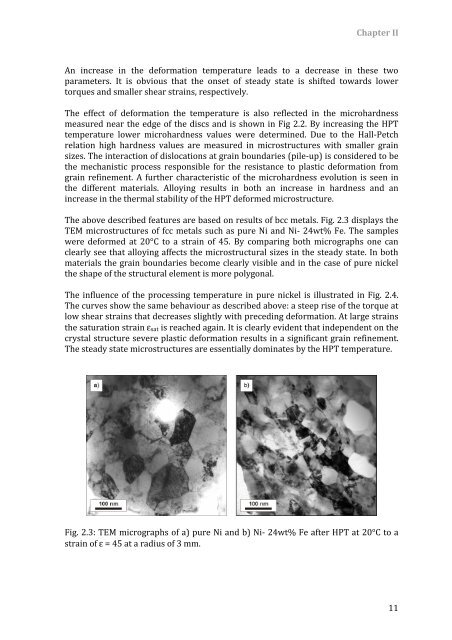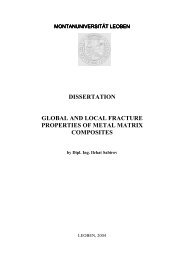Severe Plastic Deformation of Ferritic and Austenitic Steels
Severe Plastic Deformation of Ferritic and Austenitic Steels
Severe Plastic Deformation of Ferritic and Austenitic Steels
You also want an ePaper? Increase the reach of your titles
YUMPU automatically turns print PDFs into web optimized ePapers that Google loves.
Chapter II<br />
An increase in the deformation temperature leads to a decrease in these two<br />
parameters. It is obvious that the onset <strong>of</strong> steady state is shifted towards lower<br />
torques <strong>and</strong> smaller shear strains, respectively.<br />
The effect <strong>of</strong> deformation the temperature is also reflected in the microhardness<br />
measured near the edge <strong>of</strong> the discs <strong>and</strong> is shown in Fig 2.2. By increasing the HPT<br />
temperature lower microhardness values were determined. Due to the Hall-Petch<br />
relation high hardness values are measured in microstructures with smaller grain<br />
sizes. The interaction <strong>of</strong> dislocations at grain boundaries (pile-up) is considered to be<br />
the mechanistic process responsible for the resistance to plastic deformation from<br />
grain refinement. A further characteristic <strong>of</strong> the microhardness evolution is seen in<br />
the different materials. Alloying results in both an increase in hardness <strong>and</strong> an<br />
increase in the thermal stability <strong>of</strong> the HPT deformed microstructure.<br />
The above described features are based on results <strong>of</strong> bcc metals. Fig. 2.3 displays the<br />
TEM microstructures <strong>of</strong> fcc metals such as pure Ni <strong>and</strong> Ni- 24wt% Fe. The samples<br />
were deformed at 20°C to a strain <strong>of</strong> 45. By comparing both micrographs one can<br />
clearly see that alloying affects the microstructural sizes in the steady state. In both<br />
materials the grain boundaries become clearly visible <strong>and</strong> in the case <strong>of</strong> pure nickel<br />
the shape <strong>of</strong> the structural element is more polygonal.<br />
The influence <strong>of</strong> the processing temperature in pure nickel is illustrated in Fig. 2.4.<br />
The curves show the same behaviour as described above: a steep rise <strong>of</strong> the torque at<br />
low shear strains that decreases slightly with preceding deformation. At large strains<br />
the saturation strain εsat is reached again. It is clearly evident that independent on the<br />
crystal structure severe plastic deformation results in a significant grain refinement.<br />
The steady state microstructures are essentially dominates by the HPT temperature.<br />
Fig. 2.3: TEM micrographs <strong>of</strong> a) pure Ni <strong>and</strong> b) Ni- 24wt% Fe after HPT at 20°C to a<br />
strain <strong>of</strong> ε = 45 at a radius <strong>of</strong> 3 mm.<br />
11
















